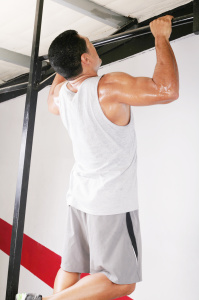Rest-Pause Reps for Singles
 In the last article I discussed guidelines for how to use single repetitions when using near maximum weights, and how they can also be used as warm up reps. In this article, I am going to discuss another method for using single reps called rest-pause reps.
In the last article I discussed guidelines for how to use single repetitions when using near maximum weights, and how they can also be used as warm up reps. In this article, I am going to discuss another method for using single reps called rest-pause reps.
What are rest pause single reps? Rest pause reps are done when a lifter performs a full set of repetitions, and then he or she rests and pauses just long enough at the end of the set to be able to do only one (or sometimes two or three) more reps. I will explain both the common version of doing rest pause reps, and a precision point version of rest-pause training so that you understand the difference.
High Intensity Rest Pause
Rest pause training is most often done by lifters who subscribe to high intensity training (also known as H.I.T.) The most common method for rest pause reps is to first push a set of reps all the way to the point of failure until no more reps can be done due to fatigue. For example, a lifter may choose to do anywhere between 5 to 12 reps for a given exercise. Then a very brief rest-pause period of 5 to 15 seconds is taken and the lifter resumes lifting the same weight and exercise. Since 5 to 15 seconds is not enough time to fully recover, the lifter will only be able to squeeze out one rep if they use a very short rest-pause, but a lot of lifters take a rest-pause that that is long enough to allow two or three reps before failing again. The lifter then continues to take brief rest-pauses to recover just enough strength to allow them to only be able to do one to two more reps, and they keep taking rest pauses until they are only able to grind out one rep at a time. Usually three or four rest pauses are taken at the end of the set, and as you can see, it is a variation of singles that is used in conjunction with a full set of reps.
High Intensity Rest Pause
Doing rest-pause reps at the end of a set is just one version of using rest pause singles. Another popular version of rest-pause reps was introduced with the high intensity training movement back in the 70’s. It was done with a near max weight that was repeated for one rep every 15 to 20 seconds with the goal of being able to struggle through three to four heavy singles (which often turned into force reps by the 3rd and 4th rep) in a short amount of time. Some people claim to have made great progress with this method, but I think it’s too severe for most people to make progress for an extended period of time.
Precision Point Rest Pause
The way I recommend rest pause reps is to use Precision Point Training guidelines by first doing a set for a given amount of reps that you choose to do. Be sure to stop the set with your limit rep, which is the last rep that you can do before slowing down your rep speed or rep rhythm. Then rest just long enough to regain enough strength to do one more strong rep at the same speed as your previous reps.
We’ll use Steve as an example precision point rest pause training and assume he does 10 pull-ups and stops because his rep speed would start to slow down on his 11th rep. So Steve waits ten seconds and then does one more strong rep. The next week that Steve does pull-ups, he still does 10 pull-ups but he only gives himself 8 seconds before doing one more rep. Steve keeps reducing his rest time by a couple seconds each week until his 11th rep is added on to his set of ten reps with no rest so that he is simply doing a non-stop set of 11 reps. The idea is for Steve to gain a little strength over time until he can do his 11th rep without needing to rest or pause, or slow down his rep speed in order to do it.
Lifters and bodybuilder have been doing single rest pause reps for years and for decades. Using this method with the right training intensity is a key to making it work for you instead of against you. The severe way of using the rest pause method that the high intensity lifters use can only be done once in a while. However, you can use the less intense method of rest pause training that I described on a regular basis. Look for smarter ways, not just a harder ways to use this method, and you can apply it in a progressive, ongoing manner. Best of training to you.
